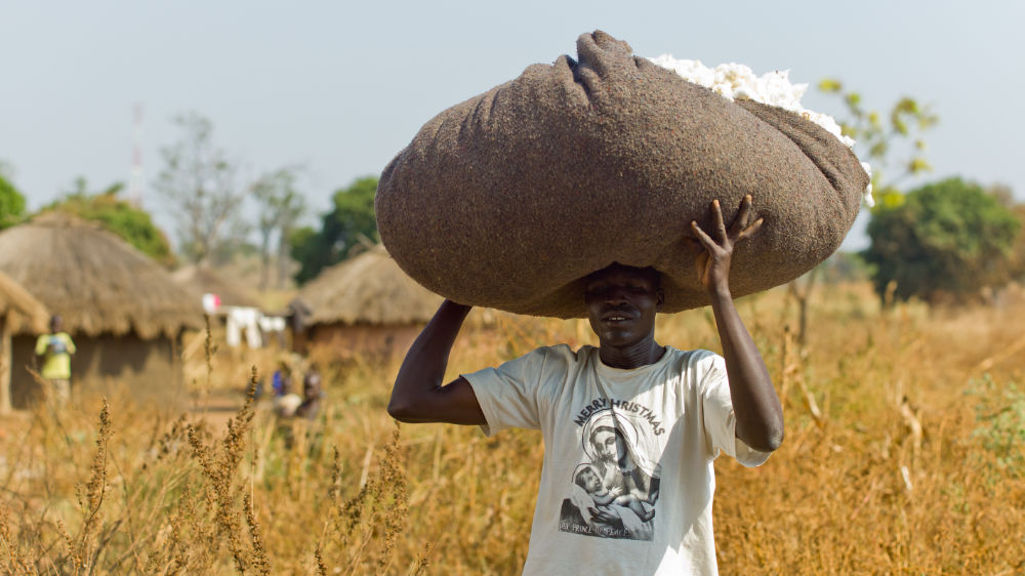Cotton textiles have a positive carbon footprint

Hand harvested organic cotton from Uganda for our Cotonea products. Picture: Klaus Mellenthin
The recently passed German supply chain law has been criticised for ignoring major environmental crises such as climate change (BUND, 6/2021). This is despite the fact that, according to studies, the fashion industry, among others, contributes dramatically to climate change (McKinsey/Global Fashion Agenda, 8/2020). If this situation does not improve, the industry's CO2 emissions will likely increase to such an extent that by 2030 it will have caused twice the amount of emissions as stipulated in the Paris Agreement. Now, a new finding suggests that cotton could be the path to a climate-friendly textile industry.
Cotton binds CO2 more effectively than other crops
“It is widely acknowledged that organic cultivation emits less CO2 than conventional crop cultivation. Among other reasons, this is because artificial fertiliser which emits greenhouse gases is not used in organic cultivation,” explains Roland Stelzer, who has been following the science for over 30 years as managing director of the organic cotton brand Cotonea. “Even I wasn’t aware until recently that the cotton plant has a positive effect on the climate and absorbs CO2 more effectively than other plants. This was recently highlighted in a scientific paper by Kai Hughes (3/2021), head of the International Cotton Advisory Committee (ICAC).
The reason for this phenomenon is that the cotton plant consists of almost 100 percent cellulose. The formation process of cellulose is decisive for the absorption of CO2. According to the ICAC study, nylon production produces the highest amount of greenhouse gases when compared to seven other fibre types. Cotton production results in the second lowest rate of emissions. Only flax fibre is said to be more climate-friendly.
The cotton cultivation for Cotonea resulted in the sequestration of 1.26 million kg of CO2 in 2020
“This is only partly true” Stelzer says, putting the ranking into perspective. “The study leaves out the fact that flax plants have to be chemically broken up to obtain the fibre. This energy-intensive processing step is not used in the production of cotton, which in turn saves on CO2.”
It may sound absurd, but the amount of cotton which is needed for 1,000g of fibre absorbs more than 2,500g of CO2. For Cotonea, this means that the brand has sequestered 1,260 tons of CO2 in the past year. Roland Stelzer points out that climate change is part of the problem that endangers the climate-positive cotton plants.
Information and explanations on the media about the environmental friendliness of cotton are important
“In the last five years we have observed an intensification of weather extremes in Uganda, where one of our cotton cultivation projects is located. Over the last three years, rainfall has increased to such an extent that the area experienced markedly high crop losses in 2020.”
Stelzer believes the spread of information via the media regarding the environmental friendliness of cotton to be an essential part of making cotton more attractive to fashion designers and producers.
“The fashion industry’s disastrous ecological footprint is largely caused by fast fashion which uses synthetic materials and blended fabrics and its associated throwaway consumerism,” says Stelzer. The existing cotton cultivation would not be sufficient to produce the current quantities for fashion items if they were all made from cotton. The solution, he said, is long-lasting textiles made of cotton: they combine positive environmental impact with fewer production steps and offer better usage due to their higher quality and durability.
On the question of whether he expects the German supply chain law to be extended to the ecological sector, Stelzer answers: “I am not aware of that being planned. But we wouldn’t be surprised if something like that were to happen. In our production processes, we do not only consider the climate, but also demonstrably protect biodiversity, soil fertility and groundwater, we do not use pesticides or genetically modified organisms - and we fulfil many other fundamental aspects of environmental protection and fair trade along the entire supply chain.”